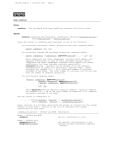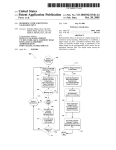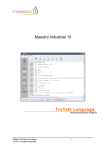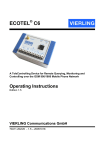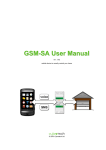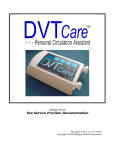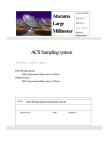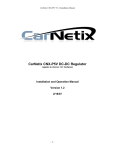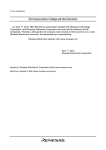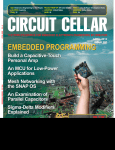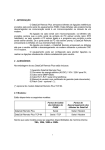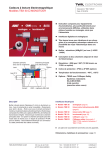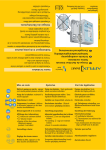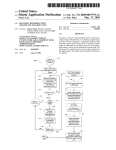Download Datacall manual - Datacall Telemetry
Transcript
Datacall Telemetry System User Manual and Programming Guide Datacall Telemetry Pty Ltd 72 Browns Rd Kingston 7050 TASMANIA Ph: +61 3 6229 0588 Fax: +61 3 6229 9245 Email: [email protected] Table of Contents 1. Document.................................................................................................................................1 1.1. Revision.............................................................................................................................1 2. Introduction............................................................................................................................2 3. Functional Description..........................................................................................................3 3.1. Alarm Monitoring Applications....................................................................................3 3.2. Control Applications.......................................................................................................4 3.3. Data logging.....................................................................................................................4 3.4. Security.............................................................................................................................4 3.5. Communication Methods................................................................................................5 4. Hardware Description............................................................................................................6 4.1. Datacall Gateway Connectors........................................................................................6 4.2. Display and Buttons........................................................................................................8 5. Installation and Wiring........................................................................................................10 5.1. Mounting (DIN Rail or Back plane)............................................................................10 5.2. SIM Card.......................................................................................................................10 5.3. Power..............................................................................................................................11 5.4. Sensors and Control......................................................................................................11 5.4.1. Digital Inputs...........................................................................................................11 5.4.2. Digital Outputs.........................................................................................................13 5.4.3. Analogue Inputs.......................................................................................................14 5.4.4. 1Wire Temperature Probe......................................................................................16 5.5. Antennas........................................................................................................................17 5.5.1. Cellular / Diversity Antennas...................................................................................17 5.5.2. GPS Antenna............................................................................................................18 6. Configuration.......................................................................................................................19 6.1. Local Configuration......................................................................................................19 6.1.1. Ethernet Connection.................................................................................................19 6.1.2. Web Browser Connection........................................................................................21 6.1.3. Changing Configuration Options.............................................................................22 6.2. Remote Configuration..................................................................................................23 6.3. Configuration Details...................................................................................................23 6.3.1. Datacall Server Section (G)......................................................................................23 6.3.2. Cellular Modem Section (M)....................................................................................24 6.3.3. Ethernet Section (G).................................................................................................25 6.3.4. Data Logging Section...............................................................................................26 6.3.5. Battery monitor Section (A5)...................................................................................27 6.3.6. Time Section (T).......................................................................................................29 6.3.7. Security Section (S)..................................................................................................29 6.3.8. Phone Numbers Section (P16).................................................................................30 6.3.9. Roster Sections (R14)..............................................................................................31 6.3.10. Digital input Sections (D18)..................................................................................34 6.3.11. Pulse Counter Sections (C14)................................................................................36 6.3.12. Analogue Input Sections (A14).............................................................................37 6.3.13. Digital Output Sections (O14)...............................................................................41 6.3.14. Job Sections (J15).................................................................................................42 6.3.15. Sensor Setup Section (W)......................................................................................43 6.3.16. Temperature Section (W1)......................................................................................44 6.3.17. Wind Speed Section (W2)......................................................................................47 6.3.18. Barometer Section (W7).........................................................................................49 6.3.19. Macro Sections (MAC15).....................................................................................49 6.3.20. Temperature Probe Section (K1)............................................................................50 6.3.21. GPS Locating Section (GPS)..................................................................................53 7. Operation..............................................................................................................................56 7.1. SMS Operation..............................................................................................................56 8. Operating Costs....................................................................................................................57 9. SMS Command Reference...................................................................................................58 9.1. Query Commands.........................................................................................................58 9.2. Control Commands.......................................................................................................59 9.3. System Commands........................................................................................................60 9.4. Configuration Commands............................................................................................60 Appendix A: Datacall Network Diagram.................................................................................61 Appendix B: Datacall Server API............................................................................................62 Appendix C: Digital Input State Diagram...............................................................................63 Appendix D: Analogue Reference Chart.................................................................................64 Appendix E: Upgrading Firmware..........................................................................................65 Appendix F: Gateway Specifications.......................................................................................66 Appendix G: Parts List.............................................................................................................67 Appendix H: Terms, Conditions & Warranty.........................................................................68 Appendix I: Notes.....................................................................................................................71 1. Document 1.1.Revision 21/2/08 22/2/08 28/2/08 28/2/08 First Draft Second Draft Final draft of first release First Release 1 2. Introduction The Datacall Telemetry system uses 3G and GSM mobile phone networks to send alarm and status information to operator’s mobile phone and a web site. The Datacall Telemetry system consists of three components: − − − Datacall Gateway Telecommunications Network Datacall Server The Datacall Gateway is the remote component of this system, it lets you monitor and interact to some degree with your remote field equipment by using SMS or the Internet. It is capable of accepting requests for the status of the unit, and values of its inputs and outputs. It will respond either via SMS or the web interface when it is requested or scheduled to do so. The Datacall Gateway is compatible with most major 3G and GSM networks available worldwide. Both SMS and IP data features are utilised by the Datacall Telemetry system. The user can interact with the unit by either SMS, the web site, or a web browser using the built in web server. The Datacall Server is able to securely store all data from all units which you operate, and has a user friendly web interface. It has features such as charting of data, and a Gateway configuration and command interface. It allows you to monitor and control each of your devices, and allows for multiple users with multiple access levels. The Datacall Gateway can be programmed to perform a specific application. Some of its features include a rostering system for alarms and scheduled commands. It has 8 digital inputs, four of which can be set as a counters for use on a pulse output metering sensor; it also has 4 analogue inputs and 4 digital outputs. The Datacall Telemetry system can be as small as a single stand alone unit monitoring a single pump or as extensive as the whole country. 2 3. Functional Description The Datacall Telemetry system provides the ability to monitor many digital inputs and analogue inputs and control digital outputs. The Datacall Gateway can also be configured to operate in a low sample rate data logging application where data is transported back to the Datacall Server. 3.1. Alarm Monitoring Applications The Datacall Telemetry system is designed to be capable of monitoring alarms on remote systems with appropriate alarm signals available. Some examples are: Pumps Circuit Breakers Temperatures Levels Pressures Signal Quality Weather Stations Power Voltage, Current Water Meters The Datacall Gateway must be integrated into the monitored system using appropriate sensors. Digital inputs can be used to monitor any alarm with two discrete states, such as Normal and Alarm. Analogue inputs are used to monitor a continuously varying quantity, such as a tank level or a temperature sensor. Analogue inputs can be set to generate alarms outside a window or on a high measurement, low measurement, or two stage critical high or critical low measurements. See Appendix D for an analogue input alarm diagram. Any alarm level can be configured for the analogue inputs. All Datacall alarms have some common options. The Datacall Gateway remains idle until one or many of the digital inputs or analogue inputs go into an alarm state. A time period (Wait Period) is specified to avoid false alarms from interference or glitches. The input must hold its alarm state until the Wait Period has expired. Once the Wait Period has expired an alarm is generated and sent to the operator via SMS, and a message is sent to the Datacall server via the Internet. 3 The operator must acknowledge the alarm if the unit is not configured as a NonUrgent Alarm. Once the alarm is acknowledged it will not be sent again until the configured Alarm Ignore Period expires. If however the alarm is not acknowledged the alarm will be sent to the next operator on the roster after the Alarm Interval elapses. Rosters allow the selection, and order of, operators to be changed. There may be a normal roster which calls Fred then Bob then Kate and a weekend roster which calls Kate then Harry. The active roster can be set to automatically change on a regular basis. The Datacall Gateway also has a battery monitor alarm, this alarm functions just like a normal analogue input but it is hardwired to measure the Datacall input voltage. The battery monitor is useful for monitoring the condition of battery and solar powered installations. 3.2. Control Applications The Datacall Gateway provides transistor driven digital outputs that can be used to control systems such as pumps, alarms, etc. The outputs can be controlled directly from the operators phone using plain words. The operator can send an SMS such as “pump on” which will activate the digital output. The Datacall Gateway will also log this activity to the web site. Timers can also be used to specify a start and stop time for the outputs. This is useful for operating irrigation pumps. 3.3. Data logging The Datacall Gateway has the ability to capture data from all of its inputs on a regular basis. This data can be stored locally for download via the web interface or transported to the Datacall Server. The Datacall Server allows users to view the data using graphing tools or export the data for detailed analysis. The locally captured data can be downloaded via the built in web interface on the Datacall Gateway. 3.4.Security The Datacall Gateway can be controlled via commands in SMS messages. To prevent unauthorised access a security pin can be configured. This PIN must prefix all commands sent to the unit unless the source phone number of the SMS is in one of the listed phone number slots. This functionality can be configured locally or remotely. The Datacall Server website is secured using an encrypted https session with a signed certificate. 4 3.5.Communication Methods The Datacall Gateway uses two primary methods for communication over the 3G or GSM mobile phone network. The first is SMS, this is used to communicate directly with operators anywhere in the world. The second method is packet data via GPRS or 3G. This service allows the Datacall unit to connect to the internet and send information to the Datacall server and web site. WARNING: The Datacall Gateway phone service must include a data access plan to avoid heavy excess charges. Datacall Telemetry recommends a 5MB plan for average usage. Network diagrams for the Datacall system can be found in Appendix A 5 4. Hardware Description 4.1. Datacall Gateway Connectors The Datacall Gateway device is an embedded computer with an embedded 3G/GSM modem and a selection of generic and specialised inputs. Illustration 1: Annotated photograph of I/O endplate 1. WAN Antenna. This connects to a suitable 3G/GSM antenna with an SMA male connector. 2. DIV/GPS Antenna. For GPS operation this connects to a suitable amplified GPS antenna. For low signal coverage use this connector with a secondary receive antenna for 3G 3. Analogue Inputs Connector. Connect up to four voltage or current analogue inputs to this connector. Details can be found in the installation and wiring section below. 4. SIM Card. This is the SIM card carrier. An active unlocked SIM card must be installed in this slot before the Datacall Gateway can function. 5. USB Port. USB Host port for future expansion. 6. Digital Inputs Connector. Connect up to eight voltage free contact digital inputs to these connectors. Details can be found in the installation and wiring section below. 7. Digital Outputs Connector. Connect up to four digital outputs to this connector. Digital outputs are opencollector transistor outputs. Details can be found in the installation and wiring section. 6 Illustration 2: Annotated photograph of power endplate 1. LAN Connector. This is a standard 10/100 Mbps Ethernet connection. This port is used for configuration and future expansion. 2. 1WireTM. The 1Wire port uses the 1Wire protocol developed by Dallas Semi conductor. This currently supports the DS18x20 series of temperature probes. 3. RS232 Serial. The RS232 port can currently be used to interface with Davis weather stations. 4. 5A Fuse. 5. 828V DC. This two pin connector supplies power to the Datacall Gateway. The power supply must be capable of handling a 2A peak current for brief moments in transmission. 7 4.2. Display and Buttons The Datacall Gateway has an LED display on the front label. This display defaults to off mode as a power saving feature. The front panel of the Datacall gateway has four buttons. RST. This is the reset button. Press this firmly to reset the device. The Datacall Gateway takes about 2 minutes to restart. TEST. This is a simple test button. Press this button to perform a simple test by sending a test message to the primary phone number and the Datacall Server. USB. This button is for future expansion. DISP. This button rotates the display mode as below. When the “DISP” button is pressed the display mode will first move to the input mode. In the input mode the LEDs numbered 18 show the current status of the digital inputs. The numbered LEDs will be active when an alarm condition is active on any of the 8 corresponding digital inputs. Please note digital input LEDs will operate even if the input is disabled in the configuration. Also note that the “Logic Sense” option will invert the status of the LEDs, meaning an open digital input contact may represent an alarm condition and therefore an active LED. The second display mode can be activated by pressing the ‘DISP’ button again, now the ‘OUTPUT’ LED will be illuminated. In this mode the numbered LEDs 14 will represent the current status of the digital outputs. If a digital output is active the corresponding LED will be illuminated. Please note that only enabled digital outputs will be displayed. The third display mode can be activated by pressing the ‘DISP’ button again, now the ‘SIGNAL’ LED will be illuminated. In the ‘SIGNAL’ mode the numbered LEDs 18 display a bar graph representing the 3G or GSM signal strength. Maximum signal strength is represented when all numbered LEDs are illuminated. As a general rule a minimum of two LEDs should be active for reliable mobile communications. If you experience less than this you should consider using a high gain antenna. Pressing the ‘DISP’ button a final time will disable the LED display return it to the off mode to save power. The display will automatically return to the off mode when left for 1 minute. 8 Illustration 3: Display Modes 9 5. Installation and Wiring 5.1. Mounting (DIN Rail or Back plane) The Datacall Gateway can be mounted using the provided standard DIN rail clips. This provides a quick and easy method for many electrical installations. If no DIN rail is available for the installation or DIN rail is not prefered the DIN rail clip can be removed from the enclosure by removing the two screws. Illustration 4: Removable DIN rail clips The Datacall Gateway has right angle brackets with pre drilled holes suitable for vertical or horizontal mounting on a backplane. 5.2. SIM Card The Datacall Gateway requires an active SIM card with Internet packet data access to communicate with the Datacall Server. The SIM card should have the security PIN disabled before it can be used with the Datacall Gateway. 10 5.3. Power The Datacall Gateway is supplied standard with a 240V AC plug pack with 12V DC output terminated with a connector suitable for the Datacall Gateway. Illustration 5: Standard 12V DC power supply An installation with 240V AC available should consider using a 12V DC sealed lead acid battery for a backup supply if the mains fails. Datacall Telemetry can supply a suitable battery and battery charger. The Datacall Gateway draws an average current of approximately 100mA at 12V. This makes it suitable for use in installations where solar power is the only source available. Datacall Telemetry can design supply and install all the components required for a more complex reliable solar installation. 5.4. Sensors and Control The Datacall Gateway can interface with many different sensors. 5.4.1. Digital Inputs Digital inputs are inputs with two discrete states, for example, “Normal” and “Alarm” or “Opened” and “Closed”. The Datacall Gateway accepts 8 digital inputs, all the Datacall 11 Gateway digital inputs are designed to operate as voltage free contacts. The signal line has an internal weak pullup resistor, when the signal line is pulled to ground this is sensed as a closed contact. Digital inputs are available on the connectors labeled D14 and D58: Pin Function Pin Function 1 D1 1 D5 2 GND 2 GND 3 D2 3 D6 4 GND 4 GND 5 D3 5 D7 6 GND 6 GND 7 D4 7 D8 8 GND 8 GND An example digital input is shown below: Illustration 6: An example simple mains failure digital input In this example the 240V AC mains is monitored using a suitable relay. When the relay contact is closed the D1 signal line is pulled to ground and the Datacall Gateway senses the closed contact. 12 5.4.2. Digital Outputs The Datacall Gateway provides four digital outputs. This allows simple control of equipment that operates in two states, eg. On or Off. All four digital outputs are opencollector outputs suitable for lowside switching. The outputs are available on the connector labelled O14 with the following pinout: Pin Function 1 O1 2 GND 3 O2 4 GND 5 O3 6 GND 7 O4 8 GND The following digital output example shows a simple example of switching a low power load: Illustration 7: Simple digital output example 13 The next example shows how the Datacall Gateway digital output can be configured to drive a voltage input: Illustration 8: Voltage input example 5.4.3. Analogue Inputs The Datacall Gateway has 4 analogue inputs which use an internal 10bit analogue to digital converter. The analogue inputs can either operate as 05V voltage inputs, or as 420mA current loop inputs. The Datacall Gateway does not provide loop power for a 420mA current loop. The sampled voltage or current is converted to engineering units using linear scaling and two scaling points, one at zero scale and one at full scale. Please see the configuration section for details of configuring each analogue input correctly. The analogue inputs are available on the connector labeled A14 with the following pin out: Pin Function 1 A1 2 GND 3 A2 4 GND 5 A3 6 GND 7 A4 8 GND 14 The following diagram is an example voltage analogue input: Illustration 9: An 05V analogue voltage input example The next examples are for 420mA loops: Existing 420mA loops will already have a power supply and the Datacall Gateway can be included in the loop. However you must pay attention to ground references. The Datacall Gateway analogue inputs are referenced to ground. Illustration 10: 420mA example with a powered display. 15 Illustration 11: 420mA loop with separate display and power supply If the Datacall Gateway can't be included in the existing loop without shorting it to ground then a loop isolator transformer may be required. 5.4.4. 1Wire Temperature Probe The Datacall Gateway supports the Dallas 1Wire bus. The Datacall Gateway currently only supports one temperature probe device on this bus. The RJ12 connector on the Datacall Gateway has the following pin out. Pin Function 3 Data / Parasite Power 4 Ground Temperature probes must be based on the DS18S20 or DS18B20 sensors available from Dallas Semiconductor. Probes suitable for outdoor use can be sourced through Datacall Telemetry. Illustration 12: 1Wire Temperature Probe 16 5.5. Antennas 5.5.1. Cellular / Diversity Antennas The Datacall Gateway is supplied standard with a 3dBi cellular antenna. This antenna is suitable for connection to UMTS 850 MHz networks, including Telstra NextG(tm). The Datacall Gateway antenna connections are both SMA female, the supplied cellular antenna is supplied preterminated with a suitable SMA male connector. Illustration 13: Standard antenna The standard antenna supplied is ground independent and is suitable to be mounted on plastic enclosures. To improve the received signal strength try mounting the antenna clear of obstructions. Lifting the antenna mounting a few metres high can vastly improve the signal strength. Datacall can supply suitable high gain antennas for use in low signal areas. The Datacall Gateway also includes a diversity antenna connection for more reliable communications in low signal areas. To use diversity receive connect another 850MHz antenna via the DIV/GPS SMA antenna port. 17 5.5.2. GPS Antenna The Datacall Gateway includes an integrated GPS receiver available on the GPS/DIV connector. A suitable GPS antenna is not supplied standard. Datacall Telemetry can supply a suitable combined GPS and cellular antenna. GPS antennas are typically active antennas with a built in amplifier. A power injector is required to power the antenna. The Datacall Gateway can be ordered with a built in GPS power injector. 18 6. Configuration The Datacall Gateway can be configured either locally, or remotely using the Datacall web site. All configuration options are available both locally and remotely. 6.1. Local Configuration The Datacall Gateway includes an embedded web server where all configuration options can be changed. Any changes made to the local configuration will be synchronised with the Datacall Server within a few minutes. 6.1.1. Ethernet Connection The Datacall Gateway must be connected to your PC using the supplied Ethernet cable. A crossover cable is not required for direct connection to a PC because the Datacall Gateway is capable of auto detecting crossover or straight through connections. The Datacall Gateway runs an embedded DHCP server by default, this will automatically configure the IP address for the connected PC. The PC must be configured to use automatic addressing, which is usually the default on most operating systems. On Microsoft Windows XP goto Control Panel > Network Connections. Right click on the Local Area Connection you wish to use for the Datacall Gateway, then select properties. Now choose Internet Protocol (TCP/IP) and select properties. Select “Obtain IP address automatically” and “Obtain DNS server address automatically” and click OK. Connect the Ethernet cable to a free Ethernet port on your PC and to the Datacall Gateway. If a link is established the Datacall Gateway LINK/ACT led will be illuminated. Please allow 1020 seconds for the automatic configuration of the PC IP address. 19 Illustration 14: Automatic IP address settings for Windows If you are using another operating system other than Microsft Windows please consult the documentation for your operating system for details on configuring TCP/IP. You should now have an active network connection to the Datacall Gateway. 20 6.1.2. Web Browser Connection Once you have a successful Ethernet connection you can load your web browser (eg. Internet Explorer, Firefox or Safari). The browser must be configured for a direct internet connection with no proxy servers enabled. The default IP address of the Datacall Gateway is 192.168.0.10 . Using the address bar of the browser navigate to “http://192.168.0.10”. The default username and password are as follows: username: admin password: password If your connection was successful you will see the main menu of the Datacall Gateway embedded web page. Illustration 15: Datacall Gateway embedded web page Each menu option is explained in the body of the page. 21 6.1.3. Changing Configuration Options To change a configuration option select Datacall Configuration and then expand the group of choice and select the section required. All the configuration options for this section will now be displayed in the body of the page. Descriptions of each field are provided as an online reference for each configuration property. Most changes can be saved and take effect immediately, some properties are noted as needing a Datacall Gateway restart. Any configuration changes will be synchronised on the Datacall Server within a few minutes of the change being saved. Illustration 16: Configuration menu 22 6.2. Remote Configuration All configuration options which are available using the embedded web server in the Datacall Gateway are available remotely using the Datacall Server website. Once you have an active account on the Datacall Server you can select the remote device and then select configuration to view and change any configuration option. Changes from the Datacall web site will be sent to the remote device immediately. 6.3. Configuration Details Please use the online help, or the reference available below 6.3.1.Datacall Server Section (G) Properties: 6.3.1.1.Name (name) Type: Text Choose a name for your Datacall Gateway. This name will be used to identify the device on the website and in SMS text messages. 6.3.1.2.Server address (serveraddress) Type: Text The Internet address of a Datacall Server (Default = server.datacall.net.au). This must remain unchanged unless you are running your own licensed Datacall Server. 6.3.1.3.Server port (serverport) Type: Number The TCP Port for Datacall Server (Default = 3280) 23 6.3.1.4.Data connection policy (conpolicy) Type: Select Option • Always On • On Demand • Disabled • Always On: A data connection is maintained with the server at all times. (increased power usage, decreased latency for server side commands) • On Demand (Default): Data connections are established on demand. • Disabled: Data connections disabled, no web site functionality available. Including remote support from Datacall (not recommended) 6.3.1.5.Log all messages (messagelog) Type: True or false All incoming and outgoing SMS messages to and from the Datacall Gateway are logged and available on the Datacall Server web site. 6.3.1.6.Automatic updates (autoupdate) Type: True or false If enabled the Datacall Gateway unit will periodically check for software patches from the configured Datacall Server. 6.3.2.Cellular Modem Section (M) Properties: 6.3.2.1.Radio band (band) Type: Select Option • Automatic • EDGE/GPRS/GSM 850/900/1800/1900 MHz (2G) TM • WCDMA/UMTS 850/1900/2100Mhz (3G, NextG ) • Automatic (Default): Let the modem automatically choose the best band. 24 • • EDGE/GPRS/GSM 850/900/1800/1900 MHz (2G): Force the modem to use GSM bands WCDMA/UMTS 850/1900/2100Mhz (3G, NextGTM): Force the modem to use 3G bands 6.3.2.2.Datalog signal quality (datalogcsq) Type: True or false Select this if you want to data log the modem signal strength. 6.3.2.3.Enable signal quality alarm (csqalarm) Type: True or false Select this if you want a signal quality alarm (viewable on the Datacall Server web site). 6.3.2.4.SMS notification (csqalarmsms) Type: True or false Select this if you want the signal quality alarm to be sent to the current operator. 6.3.2.5.Maximum SMS's per day (smslimit) Type: Number Set this to limit the outgoing SMS's from the device. (0 = disabled). All SMS's over this limit will be blocked. 6.3.3.Ethernet Section (G) Properties: 6.3.3.1.Enable DHCP client (dhcpclient) Type: True or false Enable this if you are connecting your Datacall device to an existing Ethernet network with an existing DHCP server. 25 6.3.3.2.Static IP address (ipaddress) Type: Text This IP address will be used if the DHCP client is disabled or unable to assign an IP address. 6.3.3.3.Subnet mask (netmask) Type: Text This Subnet mask will be used if the DHCP client is disabled or unable to assign a subnet mask. 6.3.3.4.Default gateway (gateway) Type: Text This default gateway address will be used if none is assigned by DHCP. 6.3.3.5.Enable local DHCP server (dhcpserver) Type: True or false If the local DHCP server is enabled laptops and PCs directly connected will automatically configure their networking parameters. WARNING: Disable this if you are connecting your Datacall device to an existing network. 6.3.4.Data Logging Section The datalog system can be configured to send captured values to the remote Datacall Gateway server or to store samples on local flash memory. The samples can then be retrieved using the datalog status page from the web interface. Properties: 6.3.4.1.Enable data logging (enable) Type: True or false This is the global data logging enable option. If this is enabled data will be collected from inputs with individual data logging options set. If this option is disabled no data logging will occur, this option overrides individual input options. 26 6.3.4.2.Data log mode (type) Type: Select Option • Local & server • Local only • Server only 6.3.4.3.Reporting rate (reportrate) Type: Number This configures the period at which datalogged samples will be reported to the Datacall Server. 6.3.4.4.Sample rate (samplerate) Type: Number This configures the period at which values will be sampled from inputs. The values are cached until the next reporting event occurs, as configured above. 6.3.5.Battery monitor Section (A5) Properties: 6.3.5.1.Enable (enable) Type: True or false Enable the internal battery monitor. This will monitor the voltage available on the main power connector of the Datacall Gateway. 6.3.5.2.Low alarm level (level1) Type: Number This is the voltage at which a low alarm will be generated. 27 6.3.5.3.High alarm level (level2) Type: Number This is the voltage at which a high alarm will be generated. 6.3.5.4.Alarm enable (alarmenable) Type: True or false If this option is enabled the battery voltage will be continously monitored and alarms will be raised on high and low events. 6.3.5.5.Send SMS alarms (smsalarm) Type: True or false If this option is enabled an SMS will be sent to the current rostered operator when an alarm occurs. 6.3.5.6.Non urgent alarm (No Acknowledgement) (nua) Type: True or false A Non urgent alarm does not require an acknowledgement message from the operator. An urgent alarm requires the operator to reply with an acknowledgement message. 6.3.5.7.Wait period (waitperiod) Type: Number The input must remain at an alarm level for the wait period before the alarm is raised. 6.3.5.8.Alarm interval (alarminterval) Type: Number For urgent alarms, the alarm message will be repeated every time the alarm interval expires until it is acknowledged. Urgent alarms must be acknowledged before they can be cleared. 28 6.3.5.9.Ignore period (ignoreperiod) Type: Number After an urgent alarm has been acknowledged (or a non urgent alarm raised) the alarm will be raised again after the ignore period expires. 6.3.5.10.Datalog this input (datalog) Type: True or false Select this is you want to data log battery voltage to the Datacall Server web site. 6.3.6.Time Section (T) Properties: 6.3.6.1.Timezone (timezone) Type: Select Option • Australian Eastern Standard Time (AEST) GMT+10 • Australian Central Standard Time (ACST) GMT+9.5 • Australian Western Standard Time (AWST) GMT+8 • Australian Eastern Daylight Time (AEDT) GMT+11 • Australian Central Daylight Time (ACDT) GMT+10.5 • Australian Western Daylight Time (AWDT) GMT+9 The timezone is used to calculate the local time of the Datacall Gateway for scheduled jobs. This setting will not alter how times are displayed on the Datacall Server web site, this can be changed in the user preferences on the web site itself. Timezone changes require restarting the Datacall Gateway. 6.3.7.Security Section (S) Properties: 6.3.7.1.Restrict SMS's to phonebook (phonebookonly) Type: True or false 29 If enabled only commands originating from one of the configured phone numbers will be accepted. SMS's from other numbers will be silently dropped. 6.3.7.2.Enable SMS PIN (smspinenable) Type: True or false If enabled only commands prefixed with the following PIN will be accepted. 6.3.7.3.SMS PIN (smspin) Type: Number If the SMS PIN is enabled above, this password must be included at the beginning of all SMS commands. eg "1234 ?d1" 6.3.8.Phone Numbers Section (P16) Phone numbers entered here can be assigned to any rosters. Once you have entered the phone numbers of all your operators you must program the order in one of the roster sections. Roster changes can be programmed as scheduled jobs. Properties: 6.3.8.1.Phone number 1 (slot1) Type: Number 6.3.8.2.Phone number 2 (slot2) Type: Number 6.3.8.3.Phone number 3 (slot3) Type: Number 30 6.3.8.4.Phone number 4 (slot4) Type: Number 6.3.8.5.Phone number 5 (slot5) Type: Number 6.3.8.6.Phone number 6 (slot6) Type: Number 6.3.8.7.Active roster (activeroster) Type: Select Option • Roster 1 • Roster 2 • Roster 3 • Roster 4 This is the currently active roster. 6.3.9.Roster Sections (R14) Rosters allow phone numbers to be ordered for urgent SMS alarms. If the alarm is not acknowledged by the first operator a second alarm message is sent to the next operator. This repeats through all the numbers in the roster and then repeats the roster until the alarm is acknowledged. Non urgent alarms are only sent to the first number in the active roster. Properties: 6.3.9.1.Name (name) Type: Text The roster can be assigned a name eg. Normal, Weekends, Night. 31 6.3.9.2.Slot 1 (slot1) Type: Select Option • None • Phone number 1 • Phone number 2 • Phone number 3 • Phone number 4 • Phone number 5 • Phone number 6 This is the primary number. SMS's are sent to this number first. Non urgent alarms are always sent to this number. 6.3.9.3.Slot 2 (slot2) Type: Select Option • None • Phone number 1 • Phone number 2 • Phone number 3 • Phone number 4 • Phone number 5 • Phone number 6 Choose a number for this roster position. 6.3.9.4.Slot 3 (slot3) Type: Select Option • None • Phone number 1 • Phone number 2 • Phone number 3 • Phone number 4 • Phone number 5 • Phone number 6 Choose a number for this roster position. 32 6.3.9.5.Slot 4 (slot4) Type: Select Option • None • Phone number 1 • Phone number 2 • Phone number 3 • Phone number 4 • Phone number 5 • Phone number 6 Choose a number for this roster position. 6.3.9.6.Slot 5 (slot5) Type: Select Option • None • Phone number 1 • Phone number 2 • Phone number 3 • Phone number 4 • Phone number 5 • Phone number 6 Choose a number for this roster position. 6.3.9.7.Slot 6 (slot6) Type: Select Option • None • Phone number 1 • Phone number 2 • Phone number 3 • Phone number 4 • Phone number 5 • Phone number 6 Choose a number for this roster position. 33 6.3.10.Digital input Sections (D18) This section controls the configuration of digital input 1. Digital inputs can be simply wired as contacts to ground. Properties: 6.3.10.1.Enable input (enable) Type: True or false 6.3.10.2.Name (name) Type: Text Choose a name for this input. This allows easy recognition in SMS's and on the Datacall Server web site. 6.3.10.3.Alarm name (alarmname) Type: Text The alarm name is a name assigned to the alarm state of the input. For example, for door security the alarm name may be "Open". 6.3.10.4.Normal name (normalname) Type: Text The normal name is a name assigned to the normal state of the input. For example, for door security the normal name may be "Closed". 6.3.10.5.Logic sense (sense) Type: Select Option • Normally open • Normally closed This option allows digital inputs to be inverted. When normally open is selected, open contacts represent the normal state and closed contacts represent the alarm state. 34 6.3.10.6.Alarm enable (alarmenable) Type: True or false If this is enabled the Datacall Gateway will actively monitor the input and raise alarms when necessary. With this disabled the input must be interrogated for updates. 6.3.10.7.Send SMS alarms (smsalarm) Type: True or false If this option is enabled SMS messages will be used to notify the rostered operators of alarms. When this is disabled changed will only be available on the Datacall Server web site or by direct interrogation by SMS. 6.3.10.8.Non urgent alarm (nua) Type: True or false A Non urgent alarm does not require an acknowledgement message from the operator. An urgent alarm requires the operator to reply with an acknowledgement message. 6.3.10.9.Pulse alarm behaviour (pulse) Type: True or false If enabled the Datacall Gateway will only notify the user when the digital input enters an alarm state. The input will return to the normal state silently. This can be useful for alarms triggered with a single pulse. 6.3.10.10.Wait period (waitperiod) Type: Number The input must remain at an alarm level for the wait period before the alarm is raised. 6.3.10.11.Alarm interval (alarminterval) Type: Number For urgent alarms, the alarm message will be repeated every time the alarm interval expires until it is acknowledged. Urgent alarms must be acknowledged before they can be cleared. 35 6.3.10.12.Ignore period (ignoreperiod) Type: Number After an urgent alarm has been acknowledged (or a non urgent alarm raised) the alarm will be raised again after the ignore period expires. 6.3.11.Pulse Counter Sections (C14) Pulse counters can be used with meters which generate a continous pulse sequence. The Datacall Gateway will count each individual pulse. Interval logging can be performed between data log sample periodds. Pulse counters 14 are shared with digital inputs 14 on the digital input connector. Please note that the input LEDs do not operate for pulse counters. Pulse counters accumulate a total value and measure a value during a data logging interval. The total value can be reset with the SMS command +C[14] Properties: 6.3.11.1.Enable (enable) Type: True or false Enabling pulse counter 1 overrides digital input 1. 6.3.11.2.Name (name) Type: Text This name will be used in SMS's and on the Datacall Server web site. 6.3.11.3.Datalog this input (datalog) Type: True or false If enabled this input will be included in the data logging samples. 6.3.11.4.Units (units) Type: Text This is the engineering unit for the meter, eg. kL 36 6.3.11.5.Scale factor (scale) Type: Number This scaling factor will be applied to the raw count to calculate engineering units. 6.3.11.6.Precision (precision) Type: Number 6.3.11.7.Count edge/s (countmode) Type: Select Option • Falling only • Rising only • Both 6.3.12.Analogue Input Sections (A14) The Datacall Gateway has four built in analogue to digital converters. They have a 10bit resolution and are useful for monitoring slow changing voltages or currents. Please refer to the installation and wiring section of the user manual for electrical details. Properties: 6.3.12.1.Enable input (enable) Type: True or false 6.3.12.2.Name (name) Type: Text Choose a name for the analogue input. This allows easy recognition in SMS's and on the Datacall Server web site. 37 6.3.12.3.Units (units) Type: Text Please enter the engineering units for this analogue quantity. eg. m, L, degrees. 6.3.12.4.Hysteresis (hysteresis) Type: Number The hysteresis percentage will add a deadzone around the alarms levels to prevent glitches. The percentage is proportional to the full scale value. 6.3.12.5.Electrical type (electricaltype) Type: Select Option • 420mA current loop • 05 Volts Please refer to the Datacall Gateway user manual for wiring details. 6.3.12.6.Low scale value (0 Volts or 4 mA) (scale1) Type: Number Enter the engineering units equivalent to 0 volts, or 4mA. For example, a level sensor may read 0 volts at 1m. 6.3.12.7.High scale value (5 Volts or 20mA) (scale2) Type: Number Enter the engineering units equivalent to 5 volts, or 20mA. For example, a temperature sensor may read 80degrees at 20mA. 6.3.12.8.Precision (precision) Type: Number This will configure the number of decimal places that will be shown in SMS's and on the Datacall Server web site. 38 6.3.12.9.Alarm level 1 (level1) Type: Number This is the first alarm level. • For a window alarm this is the low level. • For a low alarm this is the low level. • For a critical low alarm this is the critical level. • For a high alarm this level is not used. • For a critical high alarm this is the high level. 6.3.12.10.Alarm level 2 (level2) Type: Number This is the second alarm level. • For a window alarm this is the high level. • For a low alarm this level is not used. • For a critical low alarm this is the low level. • For a high alarm this is the high level. • For a critical high alarm this is the critical high level. 6.3.12.11.Fault level (420mA Only) (faultlevel) Type: Number This is the fault level. An input below this level will generate a fault alarm (420mA only) 6.3.12.12.Alarm enable (alarmenable) Type: True or false If this is enabled the Datacall Gateway will actively monitor the input and raise alarms when necessary. With this disabled the input must be interrogated to updates. 6.3.12.13.Send SMS alarms (smsalarm) Type: True or false 39 If this option is enabled SMS messages will be used to notify the rostered operators of alarms. When this is disabled changes will only be available on the Datacall Server web site or by direct interrogation by SMS. 6.3.12.14.Non urgent alarm (nua) Type: True or false A Non urgent alarm does not require an acknowledgement message from the operator. An urgent alarm requires the operator to reply with an acknowledgement message. 6.3.12.15.Alarm type (alarmtype) Type: Select Option • Critical low alarm • Low alarm • Window alarm • High alarm • Critical high alarm Analogue inputs can be configured for five different alarm types. Please see the user manual for a detailed explanation. 6.3.12.16.Wait period (waitperiod) Type: Number The input must remain at an alarm level for the wait period before the alarm is raised. 6.3.12.17.Alarm interval (alarminterval) Type: Number For urgent alarms, the alarm message will be repeated every time the alarm interval expires until it is acknowledged. Urgent alarms must be acknowledged before they can be cleared. 6.3.12.18.Ignore period (ignoreperiod) Type: Number 40 After an urgent alarm has been acknowledged (or a non urgent alarm raised) the alarm will be raised again after the ignore period expires. 6.3.12.19.Datalog this input (datalog) Type: True or false If enabled this input will be included in the data logging samples. 6.3.13.Digital Output Sections (O14) The Datacall Gateway provides four opencollector digital outputs. Please refer to the user manual for wiring examples. Properties: 6.3.13.1.Enable output (enable) Type: True or false This enables the ouput. The output can not be set or reset when it is disabled. 6.3.13.2.Name (name) Type: Text This name is used in SMS messages and on the Datacall Server web site. 6.3.13.3.Set name (setname) Type: Text Please choose a name for the set (on) state of the output. eg. "On" 6.3.13.4.Reset name (resetname) Type: Text Please choose a name for the reset (off) state of the output. eg. "Off" 41 6.3.13.5.Default state (defaultstate) Type: Select Option • Set • Reset Please choose the default state when the Datacall Gateway starts. 6.3.14. Job Sections (J15) Scheduled jobs allow periodic operations to be programmed. Any SMS command or macro can be executed on a regular basis. The time and date patterns are configured using wildcards or specific numbers. eg A '*' in the hour field will match every hour, '*/2' will match every second hour. When all the patterns match the command will be executed. Properties: 6.3.14.1.Enable (enable) Type: True or false 6.3.14.2.Minute pattern (minute) Type: Text Minutes are from 059. '*' will match all minutes, '*/n' will match every nth minute. 6.3.14.3.Hour pattern (hour) Type: Text Hours are from 023. '*' will match all hours, '*/n' will match every nth hour. 6.3.14.4.Day pattern (day) Type: Text Days are from 131. '*' will match all days, '*/n' will match every nth day. 42 6.3.14.5.Month pattern (month) Type: Text Months are from 112. '*' will match all months. '*/n' will match every nth month. 6.3.14.6.Day of week pattern (dow) Type: Text Days of the week are from 17. '*' will match all days. '*/n' will match every nth day. 6.3.14.7.Command (command) Type: Text This is the command that will be executed when all of the patterns above match the current time. 6.3.14.8.Destination (destination) Type: Select Option • Rostered phone number • Custom phone number The scheduled command can send a result message to the current rostered user, or a specific phone number. 6.3.14.9.Custom phone number (phonenumber) Type: Text If custom phone number is selected above, this phone number will be used for result messages. 6.3.15. Sensor Setup Section (W) The Datacall Gateway can connect to a weather station using its RS232 serial port. The weather station will be interrogated periodically and the data is available just like other Datacall inputs. Properties: 43 6.3.15.1.Enable (enable) Type: True or false 6.3.15.2.Sensor type (sensortype) Type: Select Option • Davis Vantage Pro (2) Currently only the Davis Vantage Pro weather station is supported. 6.3.15.3.Wind speed unit (windunit) Type: Select Option • Kilometres / hour • Knots Please select the wind speed unit to use. The change will be reflect in all messages and on the Datacall Server web site. 6.3.15.4.Data log weather data (datalog) Type: True or false If this is enabled, weather data will be included in the regular data logging to the Datacall Server. 6.3.15.5.Sponsor note (sponsornote) Type: Text This is a free text message that will be appended to the end of SMS weather reports. 6.3.16.Temperature Section (W1) The weather station air temperature can be treated the same as general analogue inputs. It can be set up as a alarm with all of the same configuration options. Properties: 44 6.3.16.1.Alarm enable (alarmenable) Type: True or false If this is enabled the Datacall Gateway will actively monitor the input and raise alarms when necessary. With this disabled the input must be interrogated for updates. 6.3.16.2.Hysteresis (hysteresis) Type: Number The hysteresis percentage will add a dead zone around the alarm levels to prevent glitches. The percentage is proportional to the full scale value. 6.3.16.3.Precision (precision) Type: Number This will configure the number of decimal places that will be shown in SMS's and on the Datacall Server web site. 6.3.16.4.Alarm level 1 (level1) Type: Number This is the first alarm level. • For a window alarm this is the low level. • For a low alarm this is the low level. • For a critical low alarm this is the critical level. • For a high alarm this level is not used. • For a critical high alarm this is the high level. 6.3.16.5.Alarm level 2 (level2) Type: Number This is the second alarm level. • For a windows alarm this is the high level. • For a low alarm this level is not used. • For a critical low alarm this is the low level. • For a high alarm this is the high level. 45 • For a critical high alarm this is the critical high level. 6.3.16.6.Send SMS alarms (smsalarm) Type: True or false If this option is enabled SMS messages will be used to notify the rostered operators of alarms. When this is disabled changes will only be available on the Datacall Server web site or by direct interrogation by SMS. 6.3.16.7.Non urgent alarm (nua) Type: True or false A Non urgent alarm does not require an acknowledgement message from the operator. An urgent alarm requires the operator to reply with an acknowledgement message. 6.3.16.8.Alarm type (alarmtype) Type: Select Option • Critical low alarm • Low alarm • Window alarm • High alarm • Critical high alarm The temperature alarm can be configured for five different alarm types. Please see the user manual for a detailed explanation. 6.3.16.9.Wait period (waitperiod) Type: Number The input must remain at an alarm level for the wait period before the alarm is raised. 6.3.16.10.Alarm interval (alarminterval) Type: Number For urgent alarms, the alarm message will be repeated every time the alarm interval expires until it is acknowledged. Urgent alarms must be acknowledged before they can be cleared. 46 6.3.16.11.Ignore period (ignoreperiod) Type: Number After an urgent alarm has been acknowledged (or a non urgent alarm raised) the alarm will be raised again after the ignore period expires. 6.3.17.Wind Speed Section (W2) Properties: 6.3.17.1.Alarm enable (alarmenable) Type: True or false If this is enabled the Datacall Gateway will actively monitor the input and raise alarms when necessary. With this disabled the input must be interrogated for updates. 6.3.17.2.Hysteresis (hysteresis) Type: Number The hysteresis percentage will add a dead zone around the alarms levels to prevent glitches. The percentage is proportional to the full scale value. 6.3.17.3.Precision (precision) Type: Number This will configure the number of decimal places that will be shown in SMS's and on the Datacall Server web site. 6.3.17.4.Alarm level 1 (level1) Type: Number This is the first alarm level. • For a window alarm this is the low level. • For a low alarm this is the low level. • For a critical low alarm this is the critical level. • For a high alarm this level is not used. 47 • For a critical high alarm this is the high level. 6.3.17.5.Alarm level 2 (level2) Type: Number This is the second alarm level. • For a windwos alarm this is the high level. • For a low alarm this level is not used. • For a critical low alarm this is the low level. • For a high alarm this is the high level. • For a critical high alarm this is the critical high level. 6.3.17.6.Send SMS alarms (smsalarm) Type: True or false If this option is enabled SMS messages will be used to notify the rostered operators of alarms. When this is disabled changed will only be available on the Datacall Server web site or by direct interrogation by SMS. 6.3.17.7.Non urgent alarm (nua) Type: True or false A Non urgent alarm does not require an acknowledgement message from the operator. An urgent alarm requires the operator to reply with an acknowledgement message. 6.3.17.8.Alarm type (alarmtype) Type: Select Option • Critical low alarm • Low alarm • Window alarm • High alarm • Critical high alarm This alarm can be configured for five different alarm types. Please see the user manual for a detailed explanation. 48 6.3.17.9.Wait period (waitperiod) Type: Number The input must remain at an alarm level for the wait period before the alarm is raised. 6.3.17.10.Alarm interval (alarminterval) Type: Number For urgent alarms, the alarm message will be repeated every time the alarm interval expires until it is acknowledged. Urgent alarms must be acknowledged before they can be cleared. 6.3.17.11.Ignore period (ignoreperiod) Type: Number After an urgent alarm has been acknowledged (or a non urgent alarm raised) the alarm will be raised again after the ignore period expires. 6.3.18.Barometer Section (W7) Properties: 6.3.18.1.Elevation offset (offset) Type: Number Enter an elevation offset in hPa. This will be added to the measured barometric pressure. If you use this offset then please ensure there is no similar offset configured in the weather instrumentation. 6.3.19.Macro Sections (MAC15) Macros can be used to automate a set of commands. For example, if you commonly request battery voltage and digital input one using '?b' and '?d1' then this could be automated as one 'status' macro. Properties: 49 6.3.19.1.Name (name) Type: Text Enter a command name for this macro. Use this name to execute the macro via SMS. 6.3.19.2.Command 1 (command1) Type: Text A command to be executed as part of the macro. 6.3.19.3.Command 2 (command2) Type: Text A command to be executed as part of the macro. 6.3.19.4.Command 3 (command3) Type: Text A command to be executed as part of the macro. 6.3.19.5.Command 4 (command4) Type: Text A command to be executed as part of the macro. 6.3.19.6.Command 5 (command5) Type: Text A command to be executed as part of the macro. 6.3.20.Temperature Probe Section (K1) Properties: 50 6.3.20.1.Enable (enable) Type: True or false 6.3.20.2.Name (name) Type: Text Choose a name for this input. This allows easy recognition in SMS's and on the Datacall Server web site. 6.3.20.3.Alarm enable (alarmenable) Type: True or false If this is enabled the Datacall Gateway will actively monitor the input and raise alarms when necessary. With this disabled the input must be interrogated to updates. 6.3.20.4.Hysteresis (hysteresis) Type: Number The hysteresis percentage will add a deadzone around the alarms levels to prevent glitches. The percentage is proportional to the full scale value. 6.3.20.5.Precision (precision) Type: Number This will configure the number of decimal places that will be shown in SMS's and on the Datacall Server web site. 6.3.20.6.Alarm level 1 (level1) Type: Number This is the first alarm level. • For a window alarm this is the low level. • For a low alarm this is the low level. • For a critical low alarm this is the critical level. 51 • • For a high alarm this level is not used. For a critical high alarm this is the high level. 6.3.20.7.Alarm level 2 (level2) Type: Number This is the second alarm level. • For a windwos alarm this is the high level. • For a low alarm this level is not used. • For a critical low alarm this is the low level. • For a high alarm this is the high level. • For a critical high alarm this is the critical high level. 6.3.20.8.Send SMS alarms (smsalarm) Type: True or false If this option is enabled SMS messages will be used to notify the rostered operators of alarms. When this is disabled changed will only be available on the Datacall Server web site or by direct interrogation by SMS. 6.3.20.9.Non urgent alarm (nua) Type: True or false A Non urgent alarm does not require an acknowledgement message from the operator. An urgent alarm requires the operator to reply with an acknowledgement message. 6.3.20.10.Alarm type (alarmtype) Type: Select Option • Critical low alarm • Low alarm • Window alarm • High alarm • Critical high alarm This alarm can be configured for five different alarm types. Please see the user manual for a detailed explanation. 52 6.3.20.11.Wait period (waitperiod) Type: Number The input must remain at an alarm level for the wait period before the alarm is raised. 6.3.20.12.Alarm interval (alarminterval) Type: Number For urgent alarms, the alarm message will be repeated every time the alarm interval expires until it is acknowledged. Urgent alarms must be acknowledged before they can be cleared. 6.3.20.13.Ignore period (ignoreperiod) Type: Number After an urgent alarm has been acknowledged (or a non urgent alarm raised) the alarm will be raised again after the ignore period expires. 6.3.20.14.Datalog this input (datalog) Type: True or false If enabled this input will be included in the data logging samples. 6.3.21.GPS Locating Section (GPS) The Datacall Gateway comes with a built in GPS receiver. To use this receiver you must have a suitable antenna connected to the diversity antenna connector on the Datacall Gateway. Properties: 6.3.21.1.Enable (enable) Type: True or false 6.3.21.2.Datalog GPS coordinates (datalog) Type: True or false 53 If this is enabled the Datacall Gateway will log GPS information with the regular datalogging. 6.3.21.3.Alarm enable (alarmenable) Type: True or false If this is enabled the Datacall Gateway will monitor its location and raise an alarm if the unit moves outside a defined radius. 6.3.21.4.Alarm radius (radius) Type: Number 6.3.21.5.Send SMS alarms (smsalarm) Type: True or false If this option is enabled SMS messages will be used to notify the rostered operators of alarms. When this is disabled changes will only be available on the Datacall Server web site or by direct interrogation by SMS. 6.3.21.6.Non urgent alarm (nua) Type: True or false A Non urgent alarm does not require an acknowledgement message from the operator. An urgent alarm requires the operator to reply with an acknowledgement message. 6.3.21.7.Wait period (waitperiod) Type: Number The input must remain at an alarm level for the wait period before the alarm is raised. 6.3.21.8.Alarm interval (alarminterval) Type: Number For urgent alarms, the alarm message will be repeated every time the alarm interval expires until it is acknowledged. Urgent alarms must be acknowledged before they can be cleared. 54 6.3.21.9.Ignore period (ignoreperiod) Type: Number After an urgent alarm has been acknowledged (or a non urgent alarm raised) the alarm will be raised again after the ignore period expires. 55 7. Operation The Datacall Gateway can be operated using two main methods, SMS commands or the Datacall Website. 7.1. SMS Operation The Datacall Gateway will accept commands using SMS text messages. Please see the command reference section for a detailed explanation of all commands available. Most commands will provide a confirmation response. Note that any invalid commands (or invalid security PIN) will fail silently without a response. Any alarms that are set as urgent alarms must be acknowledged by an operator. Alarms can be acknowledged either using SMS or via the Datacall Server website. When an urgent alarm is received it will have an 'Ack' number appended to the end of the message. You can acknowledge the alarm by sending a message containing “Ack n” where n was the acknowledgment number appended to the alarm message. Some phones support replying with the orginal mesasge text, this way you can send the alarm message back the Datacall Gateway phone number to acknowledge the alarm. For example: Received: “D1: Pump = Fault (Alarm) Ack 2” (Alarm Message) Received: “D1: Pump = Fault (Alarm) Ack 2” (Alarm Message repeats) Sent: “Ack 2” (Operator SMS acknowledgement) Received: “D1: Pump = Fault (Acked)” (Acknowledge confirmation) Received: “D1: Pump = OK (Normal)” (Fault Cleared) The Datacall Gateway can accept many commands, a summary is available in section 9. 56 8. Operating Costs The Datacall Telemetry system uses public monbile phone infrastructure to provide a wide area communications network. The Datacall Gateway communicates with the internet using IP data services provided by these mobile networks. Typically mobile carriers offer bundled 'data packs' with mobile phone services. Each Datacall Gateway device requires an active SIM card with an included data allowance. WARNING: If the Datacall Gateway's mobile service does not include a data allowance then excess usage charges may be incurred. Please ensure that the mobile service used on the Gateway includes a minimum of 5MB data allowance. Please contact your mobile carrier to activate a mobile service. 57 9. SMS Command Reference 9.1. Query Commands All query commands start with “?” Command Function ?D[18] Show current state of any digital input. “D1: Door = Closed” ?B Show current battery monitor state. “A5: Battery = 13.8V (Normal)” ?A[14] Show current state of any analogue input. “A1: Tank Level = 1.4m (Normal)” ?O[14] Show current state of any digital output. “O1: Pump = Off” ?C[14] Show current state of any pulse counter input. “C1: Water = 10876kL (305kL this interval)” ?GPS Show current GPS reading. “GPS: Longitude = 147.3137, Latitude = 42.9680 (Normal)” ?M Show current cellular modem signal strength. “M: Signal Strength = 92%, 57dBm (Normal)” ?W[19] Show an individual weather input. “W1: Air Temp = 23.1C (Normal)” wn Show a summary of current weather conditions. “Doodys Hill Air = 15.0degC Wind Dir = 222deg Wind Spd = 8kts Rain Rate = 0mm/hr Rain = 0mm Baro = 1020hPa Hum = 62% Dew Point = 8degC www.datacall.net.au” ?K Show current temperature probe status. “K1: Temperature = 16degC (Normal)” 58 9.2. Control Commands All control commands start with “+” +C[14] Reset pulse counter total accumulator. outputName|+O[14] 0|1| setName|resetName [setTime resetTime]| [delayStart runTime] Control digital outputs setName: Configured set name resetName: Configured reset name setTime: HH:MM format action time resetTime: HH:MM format revert time delayStart: minutes to delay action runTime: minutes after action to revert Turn output on: “+O1 1” Turn output off: “+O1 0” Turn output on: “+O2 set” Turn output off: “+O2 reset” Turn output on at 6pm then off at 6:30pm: “pump on 18:00 18:30” Turn output off in 30 minutes and on again after 10 more minutes: “pump off 30 10” +GPS Set GPS anchor location “GPS: Anchor Set to 42.9680, 147.3137” +R[14] Set the current active roster “normal roster active” 59 9.3. System Commands All system commands start with “&” Command Function &P Show system status summary &R Reset Datacall Gateway 9.4. Configuration Commands Configuration commands can be used to alter any configuration property available. Commands can be sent directly or executed in a macro or scheduled job. The command format is as follows: !address.property=value address – The address of the configuration section (addresses are visible in brackets after the section name in the configuration details above) property – The property name (visible in brackets in each property description in the configuration details above) value – For boolean properties, either true or false. For select options the value is the index of the selected option. Examples: !A1.alarmenable=false !G.name=Test !T.timezone=3 (selects AEDT timezone) 60 Appendix A: Datacall Network Diagram 61 Appendix B: Datacall Server API The Datacall web site provides an Web Services SOAP 1.1 based API to allow customers to retrieve their data programmatically for application specific anaylsis or presentation. For more information on this API please contact Datacall Telemetry. 62 Appendix C: Digital Input State Diagram Illustration 17: Digital input state diagram 63 Appendix D: Analogue Reference Chart UNIT$ UNIT$ UNIT$ HIGH ALARM CRITICAL ALARM ALM2$ NORMAL ALM2$ ALM2$ HYST$ ALM2$ + HYST$ ALM2$ HYST$ NORMAL ALM2$ NORMAL HIGH ALARM ALM1$ + HYST$ HIGH ALARM LOW ALARM ALM1$ ALM1$ ALM1$ HYST$ LOW ALARM ALM1$ LOW ALARM NORMAL NORMAL t CRITICAL ALARM t HIGH / CRITICAL CRITICAL / LOW t t HIGH ALARM CRITICAL ALARM ALM2$ HIGH ALARM HIGH ALARM ALM1$ ALM1$ LOW ALARM ALM1$ LOW ALARM NORMAL UNIT$ T$ LOW ALARM ALM1$ + HYST$ ALM1$ HYST$ UNIT$ NORMAL ALM2$ NORMAL ALM1$ + HYST$ NORMAL ALM2$ + HYST$ ALM2$ HYST$ NORMAL t CRITICAL ALARM ALM2$ ALM2$ HYST$ CRITICAL ALARM t WINDOWED HIGH ALARM LOW ALARM ALM1$ + HYST$ ALARM1$ CRITICAL ALARM UNIT$ ALARM2$ W (WINDOWED) LOW ALARM LEVEL HIGH ALARM LEVEL H (HIGH / CRITICAL) HIGH ALARM LEVEL CRITICALLY HIGH ALARM LEVEL L (CRITICAL / LOW) CRITICALLY LOW ALARM LEVEL LOW ALARM LEVEL 64 Appendix E: Upgrading Firmware Although the Datacall Server can push incremental updates these are for critical bug fixes and cannot replace the entire firmware image. Major firmware upgrades will be released as image files which can be installed locally via the embedded web interface. The firmware image files should be named as follows : “datacallx.x.xxxxx.tar” On the firmware upgrade page select this file and press submit query. The upgrade process will take around 5 minutes, the web browser will not provide any feedback as this process completes. Once the process is complete a message will be displayed like the following “Firmware image installed successfully, please reset the Datacall Gateway” at this point you may proceed to reset the Datacall Gateway. Next, check all the configuration is still correct, and test the main functions of your application. You can check the firmware version under the System Status menu to verify it matches the file download. 65 Appendix F: Gateway Specifications Internal Processor: 32bit 200Mhz ARM9 Volatile Memory: 32MB SDRAM NonVolatile Memory: 128MB Flash Operating System: Linux 2.6 Communications Wireless: Wired: Protocols: 850/1900/2100 MHz 3G UMTS/HSDPA (NextG™Compatible) 850/900/1800/1900 MHz 2G GSM/GPRS/EDGE 100Mbps Ethernet SMS, TCP/IP, PPP, HTTP & M2MXML Antenna Connectors: Primary: Secondary: SMA for 3G/GSM SMA Receive diversity 3G 850/2100 or GPS Antenna Inputs and Outputs Digital Inputs: Digital Outputs: Analogue Inputs: Serial Port: Other: Location: 8 (4 with pulse counter) 4 transistor outputs (250mA max) 4 x 10bit (05 V or 420 mA) RS232 1Wire™Bus, USB Host integrated GPS receiver Power Power Supply: Power Consumption: Fuse: Dimensions: Mounting: Weight: 828V DC 100mA average (Imax 2A) M205 5A Fast Acting 150 x 105 x 40 mm Panel mount or DIN rail 500g 66 Appendix G: Parts List The following item should be included in your Datacall Gateway packaging: – – – – – Datacall Gateway 12V DC power supply 3G Antenna 1m Ethernet cable CD 67 Appendix H: Terms, Conditions & Warranty These are the standard Terms and Conditions of sale for Unless Datacall has quoted free into store prices (FIS) or free Datacall Telemetry Pty Ltd (“Datacall”), which may only be on site delivery (FOS), it is the responsibility of the Customer varied after mutual consent `in writing between Datacall and to insure the product against loss or damage prior to the the Customer. Product being despatched from Datacall. PRICES INSTALLATION All prices are net ex works our factory in Hobart unless Where Datacall or its agent undertakes to install on site, it is otherwise stated. the Customer’s responsibility to provide all service utilities Delivery charges will apply except where otherwise stated. required such as electrical services. If special equipment is The provision of variation will apply where additions or required, such as heavy lift gear at the installation site, the alterations are required over and above the specifications of the expenses involved in hiring or using such equipment and any original Product. associated charges will be the Customers. Prices are in Australian dollars unless otherwise stated. TERMS OF PAYMENT If an order is based on special quantity pricing per unit and the Unless otherwise stated or negotiated by Datacall in writing, Customer does not honour purchase of quantities scheduled, the terms are payment in full strictly within 30 days following Datacall shall invoice the Customer the difference in unit invoice or dispatch date which ever is the latter. Late payment values per quantities purchased based on original scheduled will be subject to a surcharge of 2.5% per month accumulating quantity. for any outstanding months. Unless otherwise negotiated, high GOODS AND SERVICES TAX (“GST”) value purchase orders may be subject to special payment “GST” refer to goods and services tax under A New Tax conditions i.e. payment in advance, bank guarantees. System (Goods and Services Tax) Act 1999 (GST Act) and the DELIVERY terms used have the meanings as defined in the GST Act. Unless otherwise stated in writing, delivery times are an GST has not been included in the Price and will be to the estimate only, Datacall will not accept any liability or claims Customer's account if applicable. whatsoever relating to late or non delivery, or the stated The Customer will reimburse to Datacall the amount of GST delivery time not being met for any reason. This includes but payable by Datacall as a consequence of the supply by Datacall not limited to labour shortages, strikes, lockouts, late or non of the Product pursuant to this contract. delivery of components or sub assemblies, failure of third The amount of the GST to be reimbursed by the Customer to parties or freight contractors or suppliers to perform, acts of Datacall pursuant to this clause will be paid God, fire, flood, war, rebellion, incursion, lack of freight space, contemporaneously with payment of the Price by the Customer accident or any cause beyond the control of Datacall. and the presentation by Datacall of a tax invoice. RIGHTS IN RELATION TO GOODS ACCEPTANCE OF ORDER Datacall reserves the following rights in relation to the A binding contract is entered upon signing the Schedule and purchased product until all accounts owed by the Customer to subject to these Terms and Conditions of sale. Unless Datacall are fully paid. expressly accepted in writing by Datacall, any variation, 1. Legal ownership of the goods. alteration or additions to these Terms and Conditions of Sale 2. To enter the Customer’s premises (or the premises of any will be deemed to be inapplicable. associated company or agent where the Product is CANCELLATION located without liability for trespass or any resulting A contract for the Product resulting from this agreement cannot damage and take possession of the Product.) be cancelled except by mutual consent in writing between 3. To keep or resell any Product repossessed pursuant to (2) Datacall and the Customer. Any products returned to Datacall above require a Return Goods Authorisation prior to return. A restocking fee of fifteen percent (15%) will be applied. If the Product is resold, or other products manufactured using the product sold, by the Customer, the Customer shall hold VALIDITY OF PRICE Prices offered by Datacall in the Schedule will only be valid such part of the proceeds of any such sale as represents the for 30 days unless otherwise stated. Datacall reserves the right invoice price of the Product sold or used in the manufacture of the Product sold, in a separate identifiable account as beneficial to confirm or reject Prices at the time of receipt of a signed property of Datacall and shall pay such amount to Datacall Schedule. upon request. Notwithstanding the provisions above, Datacall RISK AFTER DISPATCH 68 shall be entitled to maintain an action against the Customer for after discharge of the contract for supply of the product or the Price and the risk of the Product shall pass to the Customer otherwise) for any loss or damage suffered by the Customer as the user caused or contributed to by negligence of Datacall, its WARRANTY This is limited to twelve (12) months and is given by Datacall servants or agents, nor is Datacall liable for special, incidental, indirect or consequential loss or damage suffered by the to the Customer for Product made by Datacall. A warranty certificate must be completed by Datacall and the Customer in Customer including but not limited to economic loss, loss of profit or revenue or reputation or costs arising from the loss of order to claim under this warranty use of the product. 1. What Datacall will do If the Product fails under normal use and service because of a 5. Excluded usage The Product is expressly not to be used by the Customer in life manufacturing defect in materials or workmanship within twelve (12) months from the date of purchase Datacall will at threatening or emergency or security scenarios. *consumables include indicator lamps and illumination its option, either repair or replace the Product with an equivalent product. The repaired or replacement product will sources, items made wholly or partly of glass or ceramic be warranted under the terms of this warranty for the remainder material, electrical elements, transformer windings, electric motors, reconditioned parts and batteries. of the warranty period for the product originally supplied. NO WARRANTY 2. How to obtain warranty service No warranty is given that the Product is free of infection by To obtain warranty service the Customer must return the computer viruses or other contamination, nor that access to the product to Datacall. The Product must be accompanied by the Product or any part of it will not suffer from interruption from warranty certificate duly completed along with the Customers time to time, without notice. sales receipt or invoice. Freight and insurance is the TELECOMMUNICATIONS Customer’s responsibility. Notwithstanding the foregoing, the Customer acknowledges that from time to time the Product may be inaccessible or 3. What is not covered inoperable for various reasons, including equipment This warranty does not cover any failure of equipment not malfunctions, upgrades or modifications, or causes beyond the supplied by Datacall or any consumables* attached to or control of Datacall which are not reasonably foreseeable, forming part of the Product nor does it cover any failure of or including interruption or failure of telecommunications or damage to the product due to: digital transmission links, failure or unavailability of any third • It being connected to equipment or accessories not party product or service (including any product or service of authorised by Datacall. the designated hosting partner), hostile network attacks or • Improper handling, misuse, neglect, accident, improper network congestion or other failures. installation or non compliance with the directions for use from authorised Datacall staff; Datacall shall use all reasonable endeavours to minimize any • Any alteration or modification which in the opinion of disruption, inaccessibility and/or inoperability of the product. Datacall will affect the ability to service the Product, or • Repair by anyone other than an authorised Datacall Datacall shall employ all reasonable efforts to ensure the service agent. security and confidentiality of all Customer data transmitted • Datacall does not guarantee repair or replacement services through or stored on the Product including, without limitation, will be available after expiration of the twelve (12) maintenance of independent archival data and backup copies months warranty period. of the Customer Data and taking reasonable steps to protect the Customer data from any network attack or any other malicious, 4. Rights under the Trade Practices Act harmful or disabling data, work, code or program. It is acknowledged by Datacall that, under applicable State and SUPPORT AND MAINTENANCE Commonwealth Law certain conditions may be implied and Datacall will maintain a policy of service levels for the Product rights and remedies conferred on the Customer in relation to and answer problems and issues upon the Customer notifying the Product which cannot be excluded, restricted or modified Datacall of any problem for which it requires support. by agreement (non excludable rights). Subject to the exclusions contained in this agreement, Datacall disclaims all express or implied conditions and maintenance of the Product shall embrace software support warranties in relation to the Product other than the express (including, but not limited to, error correction, modifications to terms of this warranty and any excludable rights. Datacall’ achieve consistency with the specifications, installation of responsibility to the Customer is, where permitted , limited to updates provided by the Customer and installation of updates the undertakings stated in section 1 of this warranty and subject provided by third parties in relation to Third party software) to the above, in no event is Datacall liable (where before or 69 and maintenance of telecommunications and related The Customer is liable for all telecommunication fees equipment. including short message service (SMS), data and service The Customer is to bear full responsibility for the provision of provider fees. its own equipment and access facilities, including terminals, The Customer shall treat all information supplied to it by relevant software and telecommunications equipment. Datacall (including information comprised in any computer Datacall accepts no responsibility for any deficiency in the programs, databases and documentation) as confidential, Customer’s equipment, or for any failure by the Datacall to except to the extent that such information becomes public meet its obligations under this agreement due to a deficiency in knowledge or is required, by law, to be disclosed, Datacall the Customer's equipment. shall treat all customer confidential information, which is not subject matter in which Datacall owns intellectual property INTELLECTUAL PROPERTY RIGHTS rights, as confidential. The obligation contained in this clause The Customer shall treat all information supplied to it by Datacall (including information comprised in any computer survives the termination of this agreement. ASSIGNMENT programs, databases and documentation) as confidential, except to the extent that such information becomes public The Customer shall not in any way assign or deal with interests knowledge or is required, by law, to be disclosed, Datacall under this agreement without Datacall’s prior written consent. shall treat all customer confidential information, which is not The Customer is deemed to have assigned this agreement if subject matter in which Datacall owns intellectual property there is a change in control of the shareholding in the rights, as confidential. The obligation contained in this clause Customer. survives the termination of this agreement. PRIVACY CUSTOMER RESPONSIBILITIES Datacall will ensure that any collection, use and transfer of data The Customer will ensure the Customer data on the Product about any person in the course of the Customer using the owned by the Customer is kept secure from unauthorised Product pursuant to these Terms and Conditions complies with interference at all times including but not limited to controlling all applicable laws, rules and regulations including without authorised immediate notification to Datacall of any limitation: unauthorised use, taking reasonable use, password protection, The Information Privacy Principles in the Privacy Act 1988 precautions to prevent the spread of software (C/th); and contamination/viruses and any directions from Datacall in The National Privacy Principles under the Privacy Amendment relation to security. (Private Sector) Act 2000 (C/th); The Customer will bear the direct and indirect costs associated Spam Act 2003 (Cth). with the Customer's storage of the Customer data other than GOVERNING LAW that specified in this agreement. All transactions are subject to the laws of the State of Tasmania. 70 Appendix I: Notes 71












































































